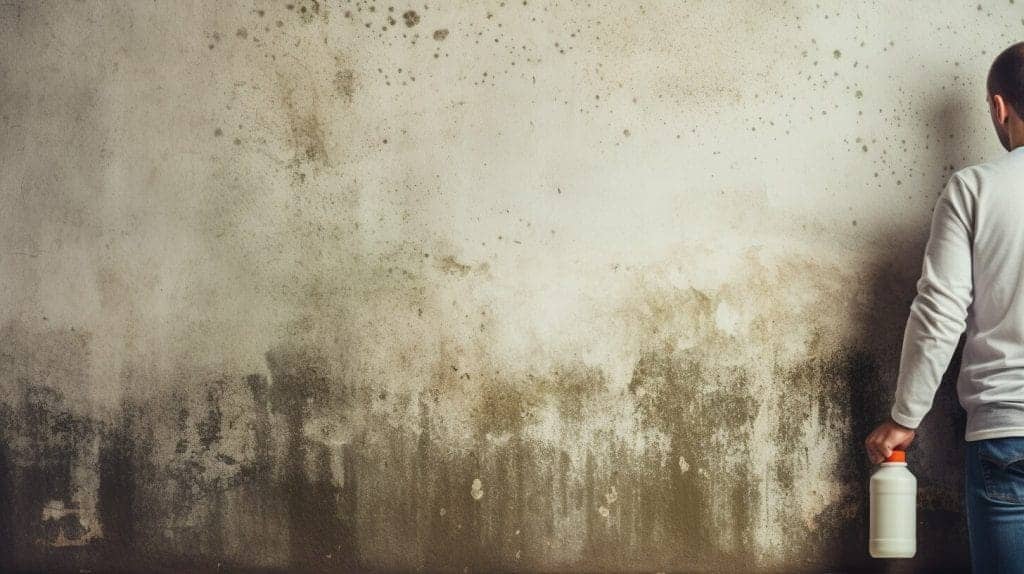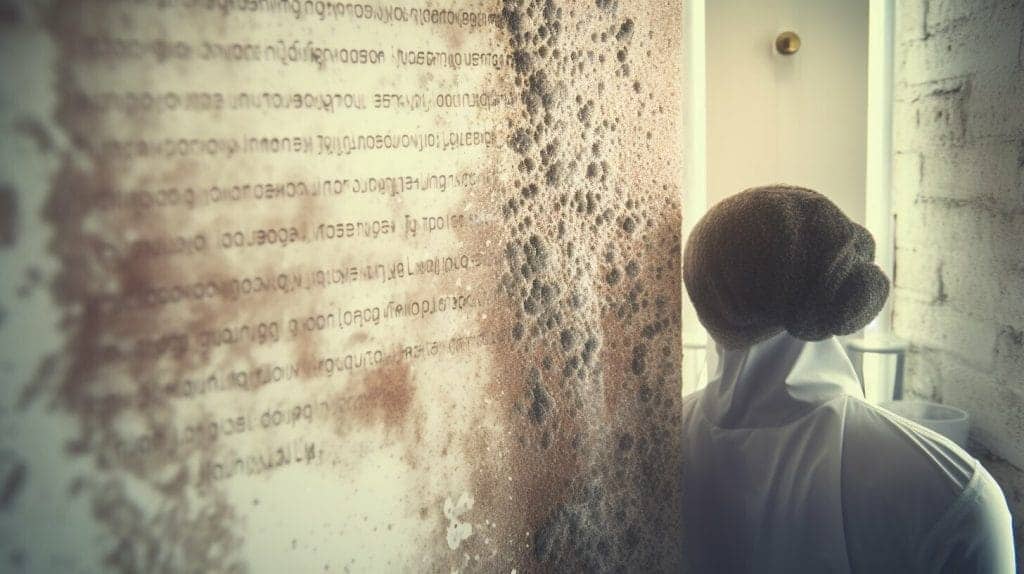Welcome to our article exploring the connection between toxic mold and blood pressure. Have you ever wondered if the mold in your home or workplace could be affecting your cardiovascular health? Mold exposure has been known to cause a range of health issues, but its impact on blood pressure is not widely understood. In this article, we will explore how toxic mold can cause a drop in blood pressure, the associated symptoms, and what you can do to protect yourself. Let’s get started!
What is Toxic Mold?
Toxic mold, also known as black mold or Stachybotrys chartarum, is a type of fungus that can grow in damp and humid environments. It releases toxic spores that can cause health problems when inhaled or touched.
Mold spores can easily spread and grow on many types of surfaces, including walls, floors, and household items. It can be difficult to detect mold, as it often grows in hidden places like behind walls and under carpets.
Mold exposure can lead to a variety of health problems, including respiratory issues, headaches, and fatigue. In some cases, mold exposure can also cause a drop in blood pressure, which can lead to symptoms like dizziness and lightheadedness.
What Causes Toxic Mold?
Toxic mold thrives in moist environments, making areas with high humidity, leaks, or flooding more susceptible to mold growth.
Common sources of moisture that can lead to mold growth include leaky roofs, plumbing issues, flooding, and high indoor humidity levels. Mold can also grow on organic materials like wood, paper, and fabric if they are exposed to moisture.
How Does Mold Exposure Happen?
Mold exposure can happen through inhalation, skin contact, or ingestion of contaminated substances.
When mold spores are released into the air, they can be inhaled and cause respiratory problems. Mold can also cause skin irritation when touched. Ingesting mold-contaminated food or substances can cause gastrointestinal symptoms.
It’s important to address any potential sources of mold in your environment to prevent exposure and protect your health.
How Does Toxic Mold Affect the Body?
When toxic mold spores are inhaled or come into contact with the skin, they can trigger a range of health problems, including a drop in blood pressure. Toxic mold releases mycotoxins that can cause inflammation in the body and disrupt various systems, including the cardiovascular system.
The mycotoxins released by toxic mold can cause the blood vessels to dilate, thereby reducing blood pressure. This effect can be particularly pronounced in individuals who are already prone to low blood pressure or hypotension.
The cardiovascular system is responsible for delivering oxygen and nutrients to all the cells in the body, including the heart. When toxic mold is present, it can cause cardiovascular problems such as arrhythmia or heart attack. Toxic mold exposure has also been linked to the development of chronic conditions such as hypertension or high blood pressure.
Effects on the Immune System
Exposure to toxic mold can also suppress the immune system, making individuals more susceptible to infections and other health problems. When the immune system is compromised, the body has a more difficult time fighting off infections, viruses, and diseases, and may also be less able to repair damaged cells or tissues.
Furthermore, toxic mold exposure can cause a range of respiratory problems, including coughing, wheezing, and shortness of breath. These symptoms can be particularly severe in individuals with pre-existing conditions such as asthma or chronic obstructive pulmonary disease (COPD).
What are the Symptoms of Mold Exposure?
Mold exposure can cause a variety of symptoms, including those related to a drop in blood pressure. Here are some common symptoms to look out for:
- Fatigue
- Dizziness
- Weakness
- Nausea
- Headaches
- Shortness of breath
- Difficulty concentrating
- Blurred vision
- Anxiety
- Depression
It’s important to note that these symptoms can also be associated with other health conditions, so it’s essential to consult a healthcare professional if you experience any of them.
Can Mold Exposure Lead to Hypotension?
Exposure to toxic mold can lead to a variety of health issues, including a drop in blood pressure. When mold spores are inhaled, they can trigger an immune response in the body, leading to inflammation and other symptoms that may cause blood pressure to drop.
If you are experiencing symptoms such as dizziness, lightheadedness, or fainting, it’s important to seek medical attention immediately to rule out any serious underlying conditions. Your healthcare provider can help determine if your symptoms are related to mold exposure or another health issue.
What are the Symptoms of Mold Exposure?
The symptoms of mold exposure can vary depending on the individual and the severity of the exposure. Common symptoms include:
- Coughing
- Sneezing
- Runny or stuffy nose
- Watery or itchy eyes
- Throat irritation
- Skin rash
- Headache
- Fatigue
- Dizziness
- Lightheadedness
- Fainting
If you experience any of these symptoms, it’s important to take steps to reduce your mold exposure and seek medical attention if necessary.
Who is at Risk for Mold Exposure?
Anyone can be exposed to toxic mold, but some groups are at higher risk than others. These include:
- Individuals with allergies or asthma
- Individuals with weakened immune systems
- Infants and young children
- Elderly individuals
- Individuals with chronic lung diseases
If you are in one of these high-risk groups, it’s important to take steps to reduce your exposure to toxic mold.
Who is at Risk for Mold Exposure?
While anyone can be exposed to toxic mold, there are some groups of people who are at a higher risk.
| Risk Factors | Description |
|---|---|
| Asthma and Allergy Sufferers | Individuals with allergies, asthma, or other respiratory conditions may experience more severe reactions to mold exposure. |
| Immunocompromised Individuals | People with weakened immune systems, such as those with HIV or undergoing chemotherapy, are more susceptible to mold-related illnesses. |
| Children and the Elderly | Young children and older adults may have weaker immune systems, making them more vulnerable to mold exposure. |
| Occupational Exposure | Those working in industries such as construction, agriculture, or janitorial services may be at a higher risk of mold exposure due to the nature of their work environment. |
| Geographic Location | Areas with high humidity or dampness, such as coastal regions or areas prone to flooding, may have a higher risk of toxic mold growth. |
How Can You Test for Mold Exposure?
If you suspect that you have been exposed to toxic mold, testing can help confirm your suspicions. There are several methods available to test for mold exposure, including:
| Testing Method | Description |
|---|---|
| Air Sampling | Air samples are collected and analyzed for mold spores and other particles. |
| Surface Sampling | Samples are collected from surfaces suspected of mold growth, and analyzed for mold spores and other particles. |
| Visual Inspection | A trained professional conducts a thorough visual inspection of the property to identify any visible signs of mold growth. |
It’s important to note that testing for mold exposure can be complex, and it’s recommended that you hire a professional to conduct the testing for you. They will be able to identify the type and severity of mold present, as well as provide recommendations for remediation.
How Can You Prevent Mold Exposure?
Mold exposure can be harmful to your health, and it is important to take steps to prevent it from occurring. Here are some tips to help you reduce your risk of toxic mold exposure:
- Control moisture levels in your home – ensure that your home is well-ventilated and use dehumidifiers if necessary. Fix any leaks immediately to prevent mold growth.
- Clean and disinfect regularly – use mold-killing products to clean surfaces prone to mold growth, such as bathrooms and kitchens.
- Use air purifiers – air purifiers can help to reduce the number of mold spores in the air, which can help to prevent exposure.
- Inspect your home regularly – regularly check for signs of mold growth in your home, such as musty odors, discoloration on walls or ceilings, and water stains.
- Be cautious when traveling – if you are traveling to a humid or damp location, be cautious and take steps to prevent mold exposure, such as using an air purifier in your hotel room.
By following these tips, you can reduce your risk of toxic mold exposure and protect your health.
What Should You Do if You Suspect Mold Exposure?
If you suspect you have been exposed to toxic mold and are experiencing symptoms, it is important to take action immediately. Here are some steps you should take:
- Leave the area: If you suspect mold is present in your home or workplace, leave the area immediately and seek fresh air.
- Seek medical attention: If you are experiencing symptoms such as dizziness, nausea, or a drop in blood pressure, seek medical attention right away.
- Contact a professional mold remediation company: If you suspect mold is present, contact a professional mold remediation company to assess and address the issue.
- Document the issue: Take photos of the mold in your home or workplace, and document any symptoms you are experiencing. This can be helpful in addressing the issue with your landlord or employer.
Remember, early detection and treatment of mold exposure can prevent serious health issues. Don’t wait to seek help if you suspect you have been exposed to toxic mold.
Can Mold Exposure be Treated?
If you suspect that you have been exposed to toxic mold and are experiencing symptoms such as a drop in blood pressure, it is important to seek medical attention. While there is no specific cure for mold exposure, there are treatments available that can help manage your symptoms and improve your overall health.
The first step in treating mold exposure is to identify and remove the source of the mold. This may involve cleaning and disinfecting affected areas, improving ventilation in your home or workplace, and fixing any leaks or moisture issues that may be contributing to mold growth.
Your doctor may also recommend medications or treatments to help manage your symptoms. This may include antihistamines to reduce inflammation and allergic reactions, pain relievers to alleviate headaches and muscle aches, and blood pressure medications to help regulate your blood pressure.
In addition to medical treatments, there are also steps you can take to improve your overall health and reduce the impact of mold exposure on your body. This includes eating a healthy diet, getting regular exercise, and reducing stress through relaxation techniques like meditation and yoga.
If you are experiencing symptoms of mold exposure, it is important to speak with your doctor and take steps to protect your health. With the right treatment and care, you can manage your symptoms and reduce your risk of complications from mold exposure.
FAQ – Frequently Asked Questions
Here are some common questions people have about mold exposure and its impact on blood pressure:
Q: Can toxic mold cause blood pressure to drop?
A: Yes, exposure to toxic mold can cause a drop in blood pressure. This is because mold can release toxins that affect the cardiovascular system, leading to hypotension.
Q: What are the symptoms of mold exposure?
A: Symptoms of mold exposure can include respiratory issues, skin irritation, headaches, dizziness, and a drop in blood pressure.
Q: How can you test for mold exposure?
A: There are various methods for testing for mold exposure, including air and surface samples, as well as blood and urine tests.
Q: How can you prevent mold exposure?
A: To prevent mold exposure, it’s important to keep your living spaces clean and dry, fix any leaks or water damage promptly, ensure proper ventilation, and use dehumidifiers if necessary.
Q: What should you do if you suspect mold exposure?
A: If you suspect mold exposure, it’s important to seek professional help and get your living spaces tested. You should also take steps to reduce your exposure, such as wearing protective gear and increasing ventilation in your home.
Q: Can mold exposure be treated?
A: Treatment for mold exposure involves managing the symptoms and removing the source of mold. This may include taking medication to regulate blood pressure and working to eliminate the mold from your living spaces.
By staying informed about the risks of mold exposure and taking preventative measures, you can help protect yourself and your family from the harmful effects of toxic mold.
Dr. Francisco Contreras, MD is a renowned integrative medical physician with over 20 years of dedicated experience in the field of integrative medicine. As the Medical Director of the Oasis of Hope Hospital in Tijuana, Mexico, he has pioneered innovative treatments and integrative approaches that have been recognized globally for the treatment of cancer, Lyme Disease, Mold Toxicity, and chronic disease using alternative treatment modalities. Dr. Contreras holds a medical degree from the Autonomous University of Mexico in Toluca, and speciality in surgical oncology from the University of Vienna in Austria.
Under his visionary leadership, the Oasis of Hope Hospital has emerged as a leading institution, renowned for its innovative treatments and patient-centric approach for treating cancer, Lyme Disease, Mold Toxicity, Long-Haul COVID, and chronic disease. The hospital, under Dr. Contreras's guidance, has successfully treated thousands of patients, many of whom traveled from different parts of the world, seeking the unique and compassionate care the institution offers.
Dr. Contreras has contributed to numerous research papers, articles, and medical journals, solidifying his expertise in the realm of integrative medicine. His commitment to patient care and evidence-based treatments has earned him a reputation for trustworthiness and excellence. Dr. Contreras is frequently invited to speak at international conferences and has been featured on CNN, WMAR2 News, KGUN9 News, Tyent USA, and various others for his groundbreaking work. His dedication to the medical community and his patients is unwavering, making him a leading authority in the field.
Contreras has authored and co-authored several books concerning integrative therapy, cancer, Lyme Disease and heart disease prevention and chronic illness, including "The Art Science of Undermining Cancer", "The Art & Science of Undermining Cancer: Strategies to Slow, Control, Reverse", "Look Younger, Live Longer: 10 Steps to Reverse Aging and Live a Vibrant Life", "The Coming Cancer Cure Your Guide to effective alternative, conventional and integrative therapies", "Hope Medicine & Healing", "Health in the 21st Century: Will Doctors Survive?", "Healthy Heart: An alternative guide to a healthy heart", “The Hope of Living Cancer Free”, “Hope Of Living Long And Well: 10 Steps to look younger, feel better, live longer” “Fighting Cancer 20 Different Ways”, "50 Critical Cancer Answers: Your Personal Battle Plan for Beating Cancer", "To Beat . . . Or Not to Beat?", and “Dismantling Cancer.”









